Published
on 25
Feb 2021
|
All rights reserved.
|
|
|
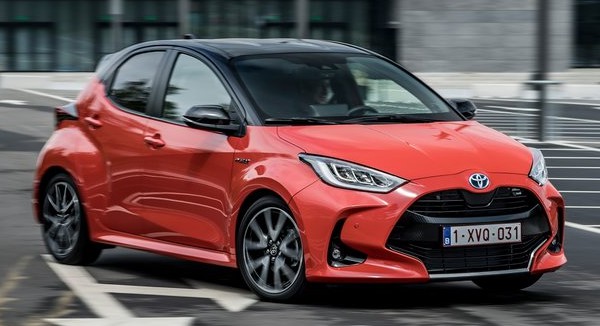
|
|
Sharp
looking and well engineered Yaris is back on form.
|
|
Launched
in 1999, Toyota Yaris was the first Japanese supermini successfully
taking the European market. In Japan, where it was called Vitz instead,
it was usually the top or one of the top selling cars of the country.
Somehow, the Mk2 and Mk3 generations fell off gradually. They did not
look as funky as the original car, nor they broke any new grounds in
terms of packaging or driving dynamics. Meanwhile, European superminis
took a giant step forward in packaging and build quality, putting the
Yaris into shade. Nevertheless, benefited by solid reliability and in
particular the fuel-saving hybrid technology, the last Yaris still sold
pretty well in Europe, capturing 224,000 sales in 2019. That’s about
the same as Ford Fiesta, unbelievably.
What if the Yaris rediscovers its lost mojo? Can it beat the heavy
hitters like Renault Clio, Peugeot 208, Ford Fiesta and VW Polo in both
sales and reputation? The 4th generation Yaris – now the name is used
across the globe – has a fair chance to do so. It has the funkiest look
since
the Mk1, an all-new platform and new engines as well. Most important,
it seems to be engineered with some driver appeal in mind, something
you cannot say for the last car.
Styling first. Doesn’t it look very sporty and aggressive? Toyota’s
styling has taken a giant leap lately, sometimes even more imaginative
than its European rivals. The new Yaris has a complex shape. Its front
grille is just as huge as the old car’s, but a lot better integrated
into the nose of the car. The sporty perception is contributed by also
the flared fenders, which stretch the body width by 50mm accompanied
with wider tracks (the Japanese version, due to tax regulation reasons,
remains at 1695mm wide). The new car keeps the same overall length, but
has its wheelbase extended by 50mm, so the four wheels are pushed right
to the corners, enhancing looks and stability. Meanwhile, the roof is
lowered by 10mm, though still taller than most rivals. At the back, the
taillight arrangement is quite creative. In addition to the optional
two-tone paint job, the new Yaris looks cool, if not as tasteful as
Peugeot 208.
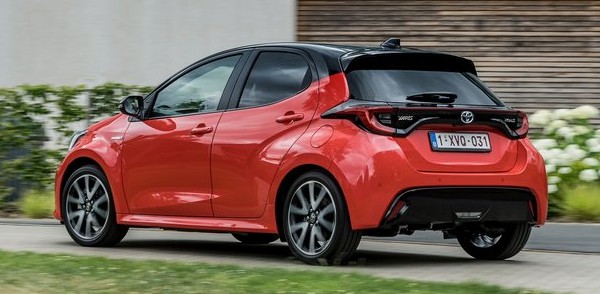
|
|
What’s
really surprising this time around is, when you up the pace, its ride
and handling don’t get out of shape too much.
|
|
The new car is derived from the GA-B platform, which is adapted from
the GA-C platform of Corolla. Its body is 37 percent stiffer
torsionally yet 50kg lighter. The tracks of European car are 60mm
wider, while center of gravity is lowered by 15mm. Moreover, the driver
seat is mounted 21mm lower and 60mm further back, closer to the center
of the car, so driver appeal is guaranteed to be improved.
Suspensions are predictably MacPerson struts up front and torsion beam
at the back, although 4WD models employ a 2-link double-wishbone setup
for the rear axle. There are 2 kinds of 4WD, a conventional one for
petrol models or an electric rear axle for Hybrid models. However, save
the GR Yaris, 4WD is available only in its home market, which is
considered necessary in Northern Japan during winter.
3 powertrains can be selected in Japan, all are 3-cylinder naturally
aspirated. The first one is a lightly improved version of the existing
1.0-liter unit. The second is an all-new, long-stroke 1.5-liter
3-cylinder with balance shaft. It belongs to the same "Dynamic Force"
family of the 2.0-liter four-cylinder seen on Corolla, featuring the
same low-friction, high-tumble flow and high EGR arrangement to achieve
the same thermal efficiency of 40 percent, which is good enough to
abandon diesel engines. This motor produces a remarkable 120hp in Japan
or 125hp in Europe, although torque output is no match for turbocharged
rivals. It can be mated with either 6-speed manual gearbox or Direct
Shift CVT. The former should be good fun.
Unfortunately, Toyota believes 80 percent buyers want the Hybrid
powertrain instead, so some European countries (like the UK) are
offered solely with the Hybrid model. Toyota’s latest 4th generation
hybrid system combines an Atkinson-cycle version of the 1.5-liter motor
with an electric CVT transaxle. Battery has been upgraded from NiMH to
Li-ion, reducing weight and boosting output at the same time. The
propulsion electric motor gets significantly more powerful, lifting
horsepower from the previous 61 to 80. This means the car can run on
battery power in more situations, boosting refinement while cutting
emission and fuel consumption by 20 percent. The combined output of 116
horsepower enables the Yaris Hybrid to go from 0-60 in 9 seconds, a
respectable kind of performance considering its class-leading fuel
economy – a true 60 mpg could be achieved in real-world driving.
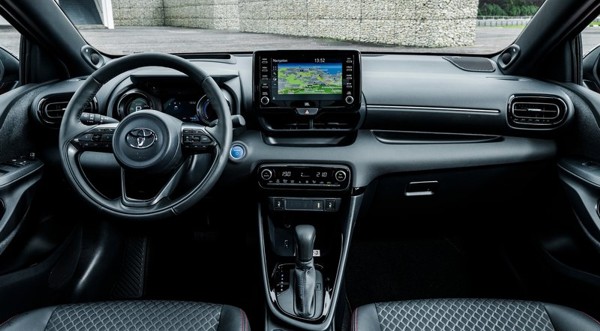
|
|
Perceived
quality is definitely an improvement from the old car and meet the
expectation of the class norm, although you will feel more premium in
Peugeot or VW.
|
|
The Yaris offers plenty of room for the driver and a good driving
position. Space at the back is average, not quite as generous as
Renault Clio or VW Polo, but not bad in the context of B-segment.
However, rear passengers feel claustrophobic due to the high waistline
and small windows. Luggage space and cabin storage is a little bit
below class standard.
The cabin’s perceived quality is definitely an improvement from the old
car and meet the expectation of the class norm, although you will feel
more premium in Peugeot or VW. Most plastics are hard but nicely
grained so that not to feel cheap. Interior design is not quite as
imaginative as the exterior, but neither is it as dull as the old car.
You use an 8- or 9-inch touchscreen to control the infotainment, whose
menus design is awkward to use and response is a little slow.
To drive, the new Yaris is again a big improvement from the old car.
Its chassis feels more rigid, delivering a quieter and smoother ride.
Refinement is not up there with the best of the class though, as there
are more wind and road noise entering the cabin at motorway speed. When
working hard at high speed or when overtaking at the fast lane, the
Atkinson-cycle motor is the weakest link, working hard and noisily to
deliver the motive force you ask for. This is especially annoying when
it switches from the silent-running electric power to gasoline power,
and the planetary CVT tends to wind the engine hard on acceleration,
although this “rubberband effect” is already reduced considreably from
its predecessor.
However, when driven in city, the Yaris Hybrid feels remarkably refined
and competent. The electric motor works quietly and provides plenty of
torque at low speed, masking the lack of turbocharging, so it feels a
tad quicker than its performance numbers suggested.
Likewise, the chassis is perfect for inner city driving. Light steering
and short turning circle make it handy to slip through narrow streets
and parking space. What’s really surprising this time around is, when
you up the pace, its ride and handling don’t get out of shape too much.
The new Yaris offers decent body control and grip, yet it doesn’t
understeer much. It is not as agile as Ford Fiesta or Mazda 2, of
course, and its steering is not as sharp either. On the other hand, its
ride is firmer than the likes of Clio, Polo or Ibiza. Opt for 17-inch
wheels, which comes with stiffer suspension setup, will make the ride
harsher still, so it is best to be avoided.
Overall speaking, the Mk4 Yaris is back on form. Even compared with its
European rivals, it is competitive enough. Sure, it is not the most fun
to drive, especially with hybrid power and CVT spoiling the fun. It is
not the most comfortable or refined. Neither is it the most upmarket
feeling. However, the small Toyota is stylish, practical, reliable and
outstandingly frugal, delivering all the core values of the brand, yet
without falling too much behind others in terms of dynamics or
perceived quality. That is good enough to guarantee market success.
|
Verdict:     |
Published
on 26
Feb 2021
|
All rights reserved.
|
|
GR Yaris
|
|
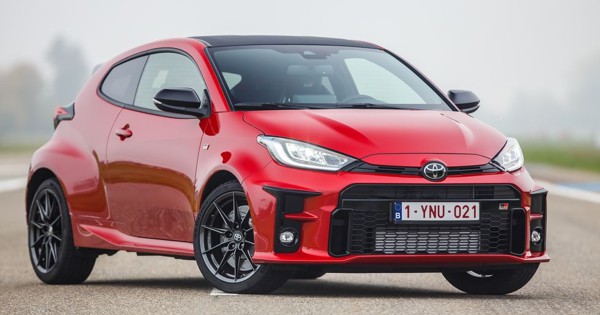
|
|
Toyota
has built a rally special that is set to be a modern classic.
|
|
This car reminds us the
golden era of rally homologation specials like Impreza WRX, Mitsubishi
Lancer Evo, Lancia Delta Integrale or Ford Escort RS Cosworth. The new
Toyota Yaris is not a poor basis for building a rally car, but Tommi
Makinen Racing, the team that ran Toyota's WRC program, demanded more.
Akio Toyoda supported the idea and greenlighted the development of a
bespoke Yaris under the Gazoo Racing label.
Although WRC regulations are quite loose, allowing a high level of
modifications, some basics cannot be changed from the production car.
One of those is the number of doors. Tommi Makinen Racing insists to
have 2 instead of 4 doors in order to cut weight and add strength to
the body shell. It also demands to have a lower and faster roof line to
improve aerodynamics - after all, rear headroom is not an issue in a
rally car. That in turn requires not only a bespoke windscreen and a
pair of doors with frameless windows but also a significantly different
body. In fact, the chassis of GR Yaris is virtually all-new. Body width
is extended by 60mm to 1805mm, allowing the use of wider tires and 36mm
wider rear track. Body rigidity is enhanced further with 259 spot welds
and an additional 15 meters of structural adhesives. To cut weight, the
roof is made of molded carbon-fiber polymer, while bonnet, doors and
tailgate are pressed aluminum. Steel panels and polymer rear bumper are
thinner. Kerb weight is 1280kg, sounds a lot for a B-segment hot hatch,
but keep listening to the ingredients it offers...
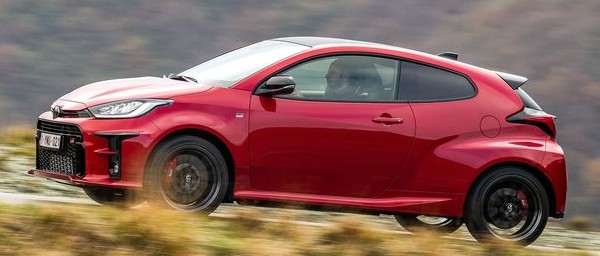
|
|
The
body, the chassis and the powertrain are all bespoke, thanks to Tommi
Makinen.
|
|
The wider rear track accommodates a new double-wishbone suspension,
which is adapted from the C-segment Corolla hatchback. The 18-inch
wheels are larger, as are the 356mm front brake discs with 4-pot
calipers. Most important, the rally special runs a 4WD system with
variable torque split. Called GR-Four system, it uses a multi-plate
clutch mounted near the rear axle to vary the torque split between
front and rear. This is made possible by using slightly faster gearing
on the rear axle, hence a speed difference of which a multi-plate
clutch can make use to transfer power rearward. In other words, the
same principles as the PSK device of Porsche 959. The torque split is
variable automatically according to driver input and traction, but the
driver can select different modes to alter the base distribution, i.e.
60:40 at Normal mode, 50:50 at Track mode or 30:70 at Sport mode. In
extreme conditions, this can be adjusted to fully front-drive or
rear-drive. Furthermore, an optional "Circuit" package adds a Torsen
LSD to
each axle, stiffer suspension setup, lighter BBS forged alloy wheels
and Michelin Pilot Sport 4S tires.
As WRC cars may use an engine different from the road cars, Toyota
skips the rally car format of 1.6-liter 4-cylinder turbo and opts for a
bespoke 3-cylinder turbo motor with codename G16E-GTS. It displaces
1618 c.c., even larger than the 1.5-liter Ecoboost unit of Ford Fiesta
ST. It has twin-variable valve timing, of course, and Toyota's D4S
direct and port injection. A relatively large turbocharger with ball
bearing and large intercooler, whose heat exchanger dominates the front
bumper, produces 261hp and 265 lbft of torque, easily becomes the most
powerful 3-cylinder engine in production. To withstand the high output,
it uses multiple oil jets to cool the pistons. Gearbox is a 6-speed
manual. Performance claim is 143mph and 0-60 in under 5.2 seconds.
That's not quite the level of Evo or STi, but easily trumps your
classic Escort RS Cosworth.
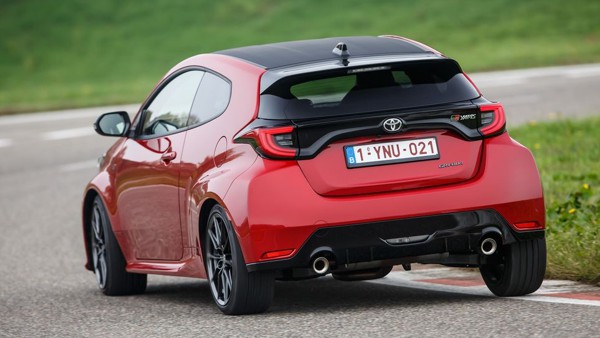
|
|
It
is a very compact car but packs a lot of power, a good AWD system and
matched with a chassis that is absorbent yet well balanced.
|
|
This is easily the fastest and most capable B-segment hot hatch on
sale. Price starting at £30,000 or £33,500 with circuit
pack, the GR Yaris is obviously sold at a loss, just like any
homologation specials. It takes a really enthusiastic boss like Akio
Toyoda to make such a dream happen.
On the Road
The GR might be less stylish than the standard Yaris, but it looks far
more purposeful from outside, thanks to that blocky front bumper with
huge cooling area – so large that you might suspect a much bigger
engine mounted behind. The extra-wide rear wheel arches give an
impression of Group B special – a sense of occasion we haven’t seen
since the days of Renault R5 Turbo and Peugeot 205 T16.
Inside, it doesn’t depart a lot from the lesser Yaris. The dashboard,
the infotainment system and the overall build quality and the slightly
dull ambience are carried over, although metal pedals and some
Alcantara trims are welcomed additions. What it has changed are good to
the driver – the gearshifter is mounted higher and closer to the
driver, the bucket seats are more supportive yet still comfortable over
long trips. Being a supermini, you inevitably sit higher than, say, a
Civic Type R, but that is necessary to overcome the higher waistline
and give you a good view on the road ahead, which is extremely
important for a rally car. Unfortunately, visibility is slightly
hampered by the thick A-pillars, and the rearview mirror suspended from
the lowered carbon-fiber roof could come in the way of your sight on
the road. While headroom is still aplenty for the driver, the same
can’t be said to the rear seat, which is cramped in both head and leg
room. A more prominent transmission tunnel robs further legroom.
Likewise, luggage space falls victim to the double-wishbone rear axle
and rear-mounted battery (the large airbox up front has its space
occupied), resulting in a dismal 174 liters. It is not as usable as a
normal hot hatch, let alone the larger Volkswagen Golf GTI or a Civic
Type R, with which the GR Yaris could compete on prices.
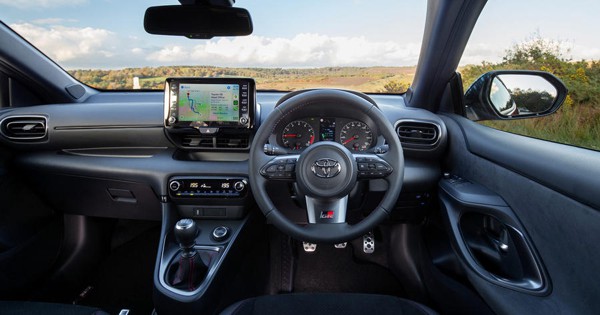
|
|
At
higher speeds you are immersed in plenty of wind and tire roar.
|
|
Even if you could live with the tiny boot and rear seat, the GR Yaris
is barely usable as a daily driver. You won’t want to take it to a long
journey, because it lacks the long-distance refinement of the
aforementioned cars. Yes, the body is stiff and free of creaks and
rattles, but the ride is a bit too stiff, and noise insulation is
obviously not the No. 1 job in its development program, so at higher
speeds you are immersed in plenty of wind and tire roar. But that is to
be expected for a rally special, isn’t it?
What the GR Yaris excels is in pure performance terms and how it
engages its driver. Toyota built a few great driving cars in the past,
such as the original MR2, the Celica GT-Four and the current GT86, but
the GR Yaris is even more intoxicating to drive hard. It is a very
compact car but packs a lot of power, a good all-wheel-drive system and
matched with a chassis that is relatively absorbent yet well balanced.
In terms of driving, it has no obvious weakness, as you will see.
You might doubt if a triple-cylinder motor could satisfy the task of
powering such a performance machine. Once you can overcome the
diesel-like clatter on startup and a slightly soft response at the
lower end, its torque comes on stream from 3000 rpm, pulling strongly
until 6000 rpm and freely towards the 7200 rpm redline. It is an
enthusiastic motor, whose sporty vocal is augmented with electronic
synthesizer through speakers, which is at least true enough to fool
you.
The quick-revving engine pairs with a light clutch and a manual gearbox
whose shift is precise and satisfyingly mechanical. As a result, the GR
begs you to drive fast, and it feels as quick as a Civic Type R.
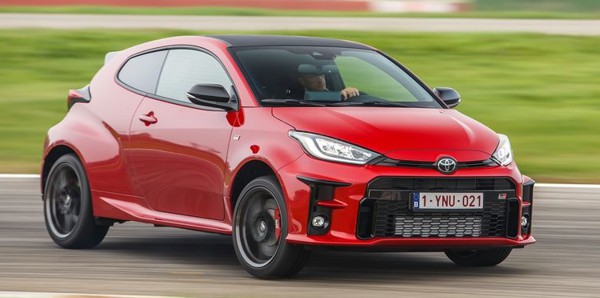
|
|
In
an increasingly digital world, the GR’s predictable, analogue handling
is a revelation.
|
|
However, what makes the GR really special is not the powertrain but the
chassis. It employs no adaptive dampers, but that doesn’t matter,
because its suspension setup is expertly judged. The low-speed ride in
town is a little hard, but once it finds a mountain road it flies with
a composure only a rally car with good suspension travel can excel.
Bumps and crests are absorbed and overcome cleanly. Small surface
irregularities
that would constantly trouble regular hot hatches are either filtered
by its
damping or absorbed by its stiff structure. It rolls in corner more
than a track-ready Civic Type R or
Megane RS for sure, but this rarely unsettles its balance and huge
reserves of grip and traction afforded by its 4WD and Torsen
differentials. Road camber, mid-corner bumps, brake
suddenly, a flick of steering and back on power… no matter what you
throw at it, its chassis just absorbs and overcomes, keeping the car
planted and stable, very much like an old Subaru STi or Mitsubishi Evo.
The brake is powerful. The steering might not be as quick as many
modern hot hatches or as feelsome as the best rivals, but it is weighty
and linear enough to feel reassuring. The balance of the chassis is
close to neutral. In Sport or Track mode it doesn’t understeer at all.
There is so much traction front and rear that it doesn’t oversteer
either. It just grips and grips, keeping you on rails. Give it a push
mid-corner will tuck its nose into the bend a little bit, but the tail
stays planted. It is therefore an incredibly quick car to attack the
twisty, especially when the road gets wet or greasy. Benefited further
by its relatively lightweight and compact dimensions, few cars can be
driven as quickly as the GR Yaris on B-roads.
If we have to be picky, we must say a little more oversteer could make
the car more playful. Even in Sport mode, it doesn’t feel like
70-percent rear-biased. You can push it to oversteer mid-corner with
throttle, steering and braking, but it will regain stability quickly,
so there is no way to hold the slide as if you can in an AMG E63 at
Drift mode. In other words, it feels more Subaru than Evo. If there is
anything separating it from the legendary Evo, it is this lack of the
final edge.
However, in an increasingly digital world, the GR’s predictable,
analogue handling is a revelation. It brings back our fond memory of
the 1990s, when rally specials became incredibly fast yet still felt
mechanical, transparent and truly engaging. Toyota has created another
modern classic.
|
Verdict:      |
Published
on 9
Aug 2024
|
All rights reserved.
|
|
GR Yaris update 2024
|
|
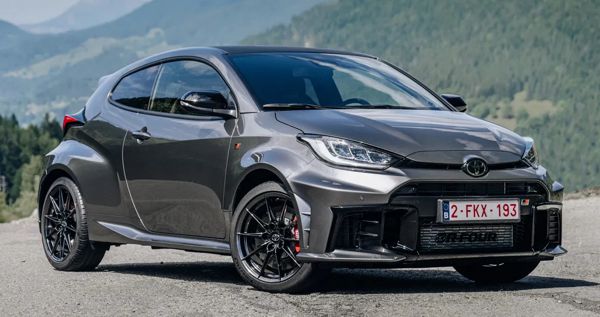
|
|
Updated
GR Yaris trades some old-school fun for serious speed...
|
|
GR Yaris
receives a mid-life update this year. Headline improvement is the
1.6-liter 3-cylinder turbo engine, which gets higher boost pressure,
higher fuel injection pressure, strengthened valvetrain, more
heat-resisting exhaust valves, lighter pistons, more durable piston
rings and intercooler water spray, among others, to lift output from
261 to 280 hp and peak torque from 265 to 288 lbft. That's just the
European version. For Japanese domestic version, it improves even more,
from 272 to 304 hp (now matching GR Corolla) and torque from 273 to 295
lbft. Moreover, the torque curve is no peakier, as it is unchanged from
idle until 3000 rpm where the old engine peaked, then rises further to
the new peak 250 rpm later and maintains the gap until 7000 rpm redline.
To cope with increased torque, the 6-speed manual gearbox is
strengthened, but more surprising is the introduction of an automatic
gearbox option. It is an 8-speed torque converter auto, but Toyota
guarantees sportier shift program and quick shift times, accompanied
with more gears hence closer ratios. It is 0.3s quicker than the
6-speed manual to go from rest to 60 mph, while lap time on track will
be quicker as well. The auto box adds 20 kg though.
The GT-Four all-wheel drive system keeps its hardware of a multi-plate
clutch for torque split and a Torsen LSD at each axle like the previous
Circuit pack setup, which is now the only option. However, the center
torque split program has been revised. While Normal mode remains 60:40,
Sport mode is scaled back from 30:70 to 53:47 (probably to improve
durability of the multi-plate clutch). Meanwhile the previous 50:50
Track mode is now variable between 60:40 and 30:70, depending on ECU
calculation. It sounds a setback for playfulness, but it is hard to
doubt Gazoo Racing's experience gained in WRC and track racing.
As for chassis, the body is strengthened with additional spot welds and
adhesives. The front struts are fixed more rigidly with additional
bolts so that camber changes under load are minimalized. All suspension
springs are stiffer, while front anti-roll bar is slightly thicker.
There are no changes for wheels, tires or brakes though.

|
|
No-nonsense
cabin focuses on function and improved driving position.
|
|
Outside, alteration to the sheet metal is limited. The front intakes
get larger to improve cooling to radiators and brakes. The front grille
is changed from plastic to mesh steel to keep stones from damaging the
radiators. Inside, the best news is that the driver seat is now mounted
25mm lower in response to criticisms. Likewise, the dashboard's highest
point is lowered by 50mm to avoid blocking forward view. Less amusing
is the new dashboard design, which looks as if inspired by buses or
trucks, even though the new LCD instrument (finally replacing analogue
one) and driver-oriented infotainment screen are more user-friendly.
On the road, the engine feels noticeably stronger from the mid-range.
The manual gearshift swifter. It is still a better option than the
automatic, whose gearchange delays at times.
The stiffer suspension means the ride is not quite as supple as before
on B-roads, which might be seen as a regress for a rally special. On
the flipside, the car does offer tighter body control, rolls less in
corner. The steering feels heavier and sharper, too. With the revised
4WD setup, immense traction and grip let you push through corners at
huge speeds. In fact, it is now so grippy that the car feels more
serious and less playful. On public roads it is difficult to push
beyond its limit of adhesion and rotate the car. Part of the old-school
driving fun has been traded for outright speed, sadly.
When the GR Yaris went on sale 3 years ago, it was sold at a bargain
£30K, or £33,500 for Circuit pack. Having established a
good reputation, Toyota no longer wants to build the car at a loss.
Price
surges to £44K, or £46K for automatic, placing it
uncomfortably close to a Civic Type R. However, there is still nothing
else on the market that provides similar level of performance, rally
car-like handling and agility, except a used GR Yaris.
|
Verdict:      |
|